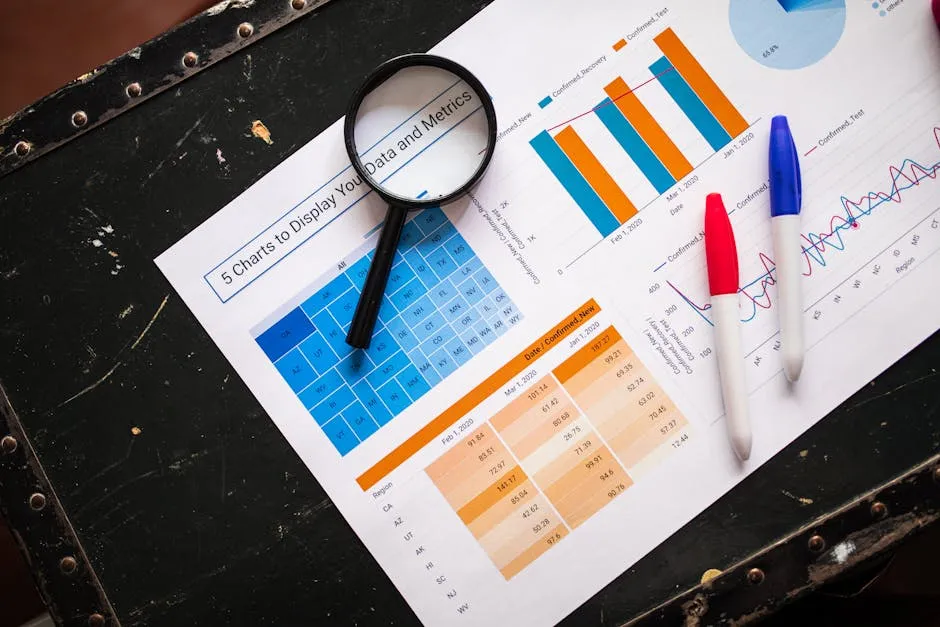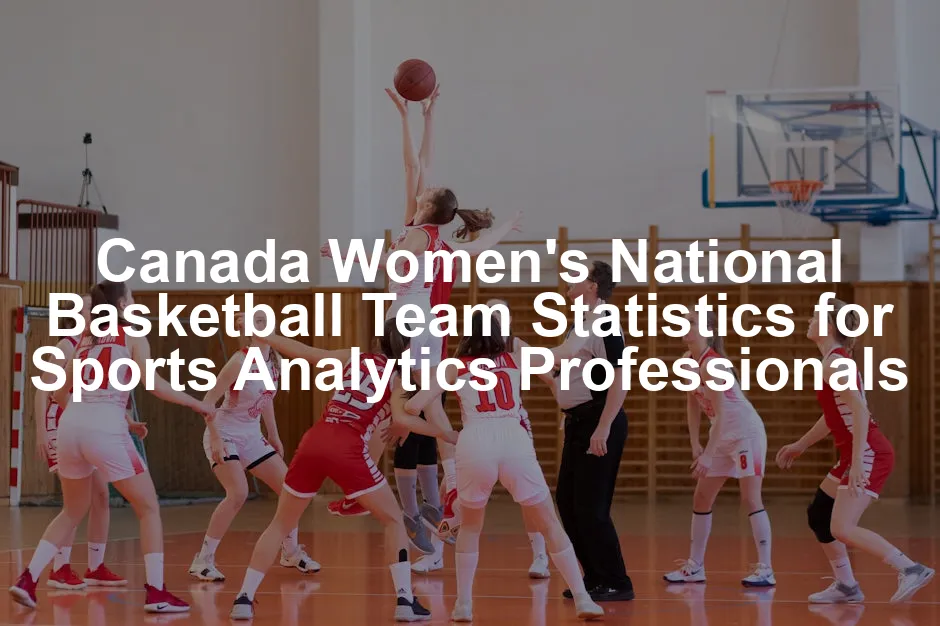Introduction
The Canada Women’s National Basketball Team has carved a significant niche in international basketball. Since its inception, this team has represented Canada in numerous prestigious tournaments, showcasing formidable talent and resilience. The squad has made impressive strides, highlighting the growing prominence of women’s basketball on the global stage. Over the years, they’ve consistently demonstrated their ability to compete with the best, earning their place in the hearts of fans and the annals of sports history.
Statistics play a crucial role in sports analytics, acting as the backbone for decisions made by coaches and analysts. They provide a lens through which teams can assess performance, identify strengths and weaknesses, and fine-tune strategies. For sports analytics professionals, diving into the data behind the Canada Women’s National Basketball Team can unlock valuable insights into player performance, game strategies, and even overall team dynamics.
With data-driven analysis, professionals can enhance team performance and individual metrics. Understanding player contributions through various statistics—like points per game, assists, and rebounds—enables teams to make informed decisions about training regimens, player development, and game strategies. This article aims to serve as a comprehensive guide for sports analytics professionals eager to dive into the statistics surrounding the Canada Women’s National Basketball Team.
By examining detailed metrics and historical data, professionals can uncover trends and patterns that inform coaching decisions and enhance player performance. This insight not only elevates the team’s competitive edge but also fosters a deeper appreciation for the art of basketball. So, grab your calculators and let’s embark on this statistical exploration of the Canada Women’s National Basketball Team!

Summary
The Canada Women’s National Basketball Team has shown remarkable performance in international competitions, including the Olympics and FIBA World Cup. Historically, Canada has consistently advanced to the medal rounds, with their crowning achievement being a bronze medal in the 2012 Olympics. At the FIBA World Cup, they have regularly placed among the top teams, securing a silver medal in 2015 and demonstrating an impressive upward trajectory in the sport.
The FIBA World Cup is a significant tournament for women’s basketball, showcasing top teams from around the world. fiba world cup statistics
Key players have emerged as stalwarts for this team. Bridget Carleton is a standout with a scoring average of 13.3 points per game and 6.3 rebounds per game. Kayla Alexander follows closely, contributing 9.3 points and 7.3 rebounds per game, showcasing her prowess both offensively and defensively. Natalie Achonwa, another vital player, has averaged 4 assists per game, underlining her role in facilitating plays and creating scoring opportunities.
Statistical analysis reveals insights into the team’s strategies as well. The Canada Women’s National Basketball Team emphasizes ball movement, evident in their assist metrics. Analyzing shooting efficiency and rebound statistics provides deeper insights into how well they control the game. Understanding these statistics allows coaches to tweak strategies for future games, enhancing player development and overall team performance.
The implications of these statistics extend beyond just numbers. They hint at potential areas for improvement, guiding training programs and player recruitment. As the landscape of women’s basketball continues to evolve, staying ahead of statistical trends will be crucial for the Canada Women’s National Basketball Team. This statistical analysis will empower sports analytics professionals to make data-informed decisions, ultimately driving the team’s success in future competitions.

Key Metrics for Analysis
When analyzing the Canada Women’s National Basketball Team, several key metrics stand out. These statistics not only provide a glimpse into individual player performance but also reveal team dynamics. Let’s break down the essential metrics used in basketball analytics.
Points per Game (PPG)
PPG measures the average points a player scores per game. This metric is crucial for identifying scoring leaders and assessing offensive contributions. For instance, Bridget Carleton leads the team with an impressive 13.3 PPG, indicating her role as a primary scorer.
Assists per Game (APG)
APG reflects the average number of assists a player records each game. This metric highlights playmaking abilities and teamwork. Natalie Achonwa shines here, averaging 4 assists per game, showcasing her ability to create scoring opportunities for teammates.
Rebounds per Game (RPG)
RPG indicates how many rebounds a player averages in a game, covering both offensive and defensive rebounds. Kayla Alexander excels in this area, leading the team with 7.3 RPG. Her rebounding prowess significantly contributes to the team’s ability to control possessions.
Shooting Percentages (FG%, 3PT%, FT%)
Shooting percentages provide insight into a player’s scoring efficiency.
– Field Goal Percentage (FG%) measures overall shooting accuracy.
– Three-Point Percentage (3PT%) assesses long-range shooting effectiveness.
– Free Throw Percentage (FT%) reflects success at the charity stripe.
These metrics combined help coaches and analysts evaluate players’ scoring efficiency, which can be pivotal in close games.
Understanding these metrics allows sports analytics professionals to spot trends and weaknesses. For example, if a player struggles with their shooting percentage, coaches might focus on targeted drills to improve that aspect. Similarly, high assist numbers can indicate effective ball movement, a crucial component of team strategy.
By leveraging these metrics, analysts can derive insights that shape coaching decisions and player development. Whether it’s identifying a rising star or strategizing for an upcoming match, these key statistics are invaluable for enhancing performance and understanding the intricate dynamics of the game.

If you’re looking to improve your training regimen or get a head start on player development, then consider investing in some basketball training equipment. Whether it’s agility ladders or shooting targets, the right tools can make a world of difference in your practice sessions.
Comparison with Other National Teams
When comparing the Canada Women’s National Basketball Team to other elite squads, such as the USA and Australia, the stats paint a vivid picture. Canada consistently holds its ground against these powerhouses. In recent Olympic Games, Canada has showcased resilience and skill, often pushing the limits against the top-ranked teams.
For instance, at the Tokyo 2020 Olympics, Canada faced the USA in the semi-finals. They put up a tough fight, ultimately losing 93-65. Yet, the gap is narrowing. Canada’s performance was marked by commendable shooting percentages and rebound statistics, earning respect even in defeat.
Meanwhile, Australia, another major contender, has also seen fierce competition with Canada. In the 2022 FIBA Women’s World Cup, Canada edged out Australia in the group stages, showcasing a strategic prowess that highlights their growth in the sport. The final score? A thrilling 70-66 win for Canada, proving their competitive standing is more than just a fluke.
Several factors contribute to Canada’s success in women’s basketball. First, the development programs in Canada have become a breeding ground for talent. Increased investment in women’s sports has bolstered player development, leading to improved performance on the international stage. Moreover, the emphasis on analytics helps coaches make informed decisions, maximizing player strengths and weaknesses.
Additionally, the cultural shift towards equity in sports is crucial. As highlighted in discussions about women in sports analytics, the growing representation of female athletes and coaches fosters a conducive environment for success. The more diverse the decision-making team, the better the outcomes—both on and off the court.

If you’re a basketball enthusiast looking to gear up for the game, don’t forget to check out some stylish basketball shoes. The right footwear can elevate your game and keep you comfortable on the court!
In conclusion, Canada’s standing among the elite women’s basketball teams is no accident. With a blend of emerging talent, strategic analytics, and a supportive culture, the team is poised for continued success in international competitions.

Advanced Analytics for Performance Improvement
Utilizing Data for Player Development
In today’s basketball arena, data is the MVP. Teams harness player data to tailor training regimens, ensuring athletes reach peak performance. Advanced metrics, such as Player Efficiency Rating (PER), are pivotal in assessing player value. The PER metric calculates a player’s overall contribution based on positive achievements—like points, assists, and rebounds—while considering negatives like turnovers and missed shots. This comprehensive view helps teams identify potential stars and strategize player development.
Moreover, data analytics can spotlight areas needing improvement. For instance, if a player has a low shooting percentage, targeted shooting drills can be implemented to enhance their skills. This method not only boosts individual performance but also contributes to overall team success.
Teams like Canada’s women’s squad utilize these insights, focusing on players’ strengths through tailored training. By analyzing performance data, coaches can determine which drills yield the best results. This approach fosters a growth mindset among players, encouraging them to embrace continuous improvement.

If you want to monitor your fitness while training, consider investing in a fitness tracker. Keeping track of your stats can help you optimize your workouts and stay motivated!
Case Studies
Case studies abound showcasing how analytics have revolutionized team performance. One notable example is the Canadian team’s journey during the 2015 FIBA Women’s World Cup. Through meticulous analysis of game footage and player stats, coaches identified defensive weaknesses in their opponents. They adjusted their strategies accordingly, leading to a surprising upset against the USA in the semifinals.
In another instance, during the recent FIBA World Cup, Canada’s coaching staff implemented real-time data tracking during games. This data allowed them to make instant adjustments, optimizing player rotations based on fatigue levels and performance metrics. The result? A bronze medal finish, highlighting the impact of data-driven decisions in high-pressure situations.
These case studies exemplify how analytics can lead to tangible success on the court. As teams increasingly rely on data, the landscape of women’s basketball continues to evolve. By harnessing advanced statistics, coaching staff can refine strategies, enhance player development, and ultimately, secure victories.

Future Trends in Women’s Basketball Analytics
The Growing Role of Women in Sports Analytics
Women are stepping up in the sports analytics arena like never before. This increase in representation is reshaping the industry. The numbers tell a compelling story: only 13% of analytics positions in major American sports leagues are held by women. However, that’s slowly changing as organizations recognize the importance of diversity.
Initiatives like the Data Dunkers program are paving the way. This innovative program, aimed at teaching data science through basketball, empowers young girls and women to engage with analytics. By providing hands-on experience, it helps demystify the field, making it more accessible.
Moreover, mentorship programs are popping up everywhere, connecting aspiring analysts with seasoned professionals. These relationships foster growth and confidence, encouraging more women to pursue careers in sports analytics. This shift not only diversifies perspectives but also enhances decision-making processes. Having women in these roles leads to better insights and improved strategies.

The impact of these initiatives is already visible. More women are landing roles in analytics teams across various sports organizations. This growing representation is crucial. It cultivates an environment where different viewpoints can thrive. The future looks bright for women in sports analytics, and the industry stands to benefit immensely.
To enhance your understanding of sports analytics, you might find it helpful to read a sports analytics book. These resources can provide deeper insights into the statistics that drive the game.

Predictions for the Canada Women’s National Basketball Team
Statistics point toward a promising future for the Canada Women’s National Basketball Team. With players like Bridget Carleton and Kayla Alexander leading the charge, the team is poised for success. Their current performance metrics are impressive—Carleton averages 13.3 points and 6.3 rebounds per game, showcasing her scoring ability and defensive prowess.
Based on recent trends, we can anticipate an uptick in overall team performance. The analytics suggest that focusing on shooting efficiency and rebound control will be key areas for improvement. As seen in recent competitions, teams that excel in these metrics often secure victories. For more on statistical trends, check out the analysis of the top statistical trends for Croatia men’s national basketball team in 2023.
Understanding statistical trends is essential for predicting team performance. top statistical trends for croatia mens national basketball team in 2023
Moreover, player development is crucial. The Canada Women’s National Basketball Team has a robust pipeline of talent, thanks to youth programs and collegiate leagues. By leveraging analytics, coaches can identify players’ strengths and tailor training regimens accordingly. This data-driven approach will enhance individual skills and contribute to overall team dynamics.

If you’re serious about your training, consider using a set of resistance bands to build strength and flexibility. They’re a versatile addition to any workout routine!
In conclusion, the future of the Canada Women’s National Basketball Team looks bright. With a focus on analytics and player development, they are positioned to make significant strides in upcoming competitions. As they continue to harness the power of data, we can expect exciting results on the court.

Conclusion
The analysis of the Canada Women’s National Basketball Team’s statistics reveals a wealth of insights for sports analytics professionals. Key performance metrics such as points per game (PPG), rebounds per game (RPG), and assists per game (APG) provide a clear picture of individual and team strengths. Bridget Carleton, for instance, has emerged as a scoring leader, averaging 13.3 PPG, while Kayla Alexander excels in rebounding with 7.3 RPG. These statistics are more than mere numbers; they are the foundation upon which strategic decisions are made.
Statistics and analytics are vital in enhancing the performance of the Canada Women’s National Basketball Team. They guide coaches in tailoring training regimens, improving player development, and refining game strategies. By understanding the nuances of shooting percentages and assist ratios, teams can gain a competitive edge and make informed decisions during high-stakes competitions. The importance of analytics cannot be overstated; they transform raw data into actionable insights.
For sports analytics professionals, engaging with the available data is essential. Utilizing statistical tools and technology, such as wearable devices and advanced analytics platforms, can significantly improve decision-making processes. With organizations like KINEXON leading the charge in sports data analytics, professionals have unprecedented access to metrics that can optimize team performance.

If you’re keen on enhancing your nutrition for better performance, check out a great sports nutrition book. Nutrition plays a crucial role in athletic performance and recovery.
In conclusion, the Canada Women’s National Basketball Team stands at a pivotal moment. By harnessing the power of statistics and analytics, they can continue to elevate their game and compete at the highest levels. Embracing these insights will not only enhance individual player performance but also contribute to the team’s overall success. It’s time for sports analytics professionals to dive into this treasure trove of data, unlocking the potential it holds for a brighter future in women’s basketball.
FAQs
What are the key performance metrics for the Canada Women’s National Basketball Team?
Key performance metrics include points per game (PPG), rebounds per game (RPG), and assists per game (APG). PPG indicates scoring ability, while RPG reflects rebounding efficiency. APG showcases playmaking skills, essential for team dynamics.
How does the Canada Women’s National Basketball Team compare to other teams?
The Canada Women’s National Basketball Team consistently ranks among the top teams globally. In competitions like the Olympics and FIBA World Cup, they have demonstrated competitiveness against powerhouses like the USA and Australia, often closing the gap in key statistical areas.
What technology is used for sports analytics in women’s basketball?
Wearable technology and data analytics platforms play a crucial role in sports analytics. Systems like KINEXON provide real-time tracking of player performance metrics, allowing teams to analyze speed, workload, and efficiency during games.
Why is representation in sports analytics important?
Diversity in sports analytics teams leads to better decision-making and innovative strategies. A variety of perspectives enhances the analysis process, ultimately benefiting the sport and its athletes. Increasing representation fosters an inclusive environment that can drive positive change in women’s sports.
Please let us know what you think about our content by leaving a comment down below!
Thank you for reading till here 🙂
All images from Pexels




